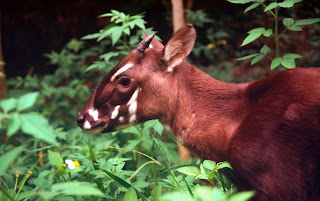
Pseudoryx nghetinhensis Saola (aka Vu Quang ox) 4 - 5 month old female at the Forest Inventory & Planning Institute Botanical Garden. Hanoi, Vietnam
Saola is a relatively new species of large mammal. In 1992, the scientific community learned about saola for the first time. This unusual-looking animal can only be found in the forests on the border between north-central Vietnam and Laos. Saola is also known as the Asian unicorn because it is rarely seen in nature, and people sometimes regard saola as a fictitious creature. Saola prefers to live in dense forests with plenty of running water (near the riverbanks). Although little is known about saola, it is classified as a critically endangered species due to rapid habitat loss and hunting. Saola horns are collected as trophies, while other parts of its body are used in folk medicine.
The saola is a large animal that resembles an antelope but is more closely related to the bovine family. It can grow to be 59 to 77 inches long and weigh between 176 and 220 pounds.
Males and females both have long, sharp, parallel-positioned horns that can grow to be 20 inches long.
Saola’s body is covered in red, brown, or dark black fur. It has a tricolored tail that is brown on top, beige in the middle, and black at the end.
Saola’s appearance and behavior are so distinct that a whole new order has been created just for this animal.
The thick skin of a saola protects it from serious injuries when two saolas collide during a fight for females or territory.
Saola is a plant-eating herbivore. It feeds on fig leaves and other plant material (seeds, fruit, and berries) found near riverbanks.
Saola is a diurnal (daytime active) animal. It is most active in the morning and late afternoon.
Because saola shares its habitat with tigers and crocodiles, these animals are considered its most dangerous predators.
Saola is a solitary creature. They sometimes congregate in herds of up to seven animals.
Males are aggressively territorial. In comparison to females, they cover a larger area. Saolas mark their territory with a sticky, stinky substance produced by the maxillary gland.
Because of a lack of water and food, saola migrate from lowland forests to the alpine mountains throughout the year.
Saola mating season overlaps with monsoon season. It takes place in Vietnam from February to March, and in Laos from April to June.
Pregnancy lasts 8 to 9 months and results in one baby (calf). Little is known about the saolas’ reproductive behavior.
Saola is thought to live in the wild for 8 to 11 years, according to scientists.
All saola information was gathered by observing 13 captive animals. Unfortunately, soalas cannot survive in captivity for long periods of time, and all but two captured animals died within a short period of time.









